Wisconsin Shipwreck Coast National Marine Sanctuary
WOULD YOU BE SURPRISED TO LEARN that treasure is beneath the surface of Lake Michigan? It’s true, and these treasures give us glimpses into our history. They aren’t found inside shipwrecks — the wrecks themselves are the treasures. The vessels were critical in how the U.S. developed from the early 1800s throughout the next century. Then the ships vanished, sometimes for 100 years or more, but the cold, fresh water preserved them as perfect time capsules.
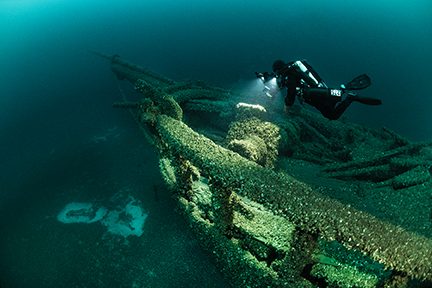
In June 2021 the National Oceanic and Atmospheric Administration (NOAA) announced that its newest designated sanctuary, the Wisconsin Shipwreck Coast National Marine Sanctuary (WSCNMS), would cover 962 square miles of Lake Michigan. WSCNMS currently has 36 identified shipwrecks within its borders, but archival information suggests others remain to be discovered. Continued archaeology and research projects are part of the sanctuary’s plan, as are additional site protections, including adding moorings to the known shipwrecks as well as engaging in community outreach and education.
Eight years ago I visited my friend and dive buddy Jitka Hanakova in Milwaukee, Wisconsin, and she had been asking me to return for more wreck diving. We finally planned to dive together along the Wisconsin coast in summer 2022. With so many great wrecks in the area, we decided to start in Sturgeon Bay, work our way down to Two Rivers, and end in Sheboygan, spending a few days or more in each location. I had a long wish list of sites with incredible shipwreck stories. Each ship had something unique that made it special. I enjoy diving wooden schooners, and this area has several possible one-of-a-kind examples.
We loaded up Jitka’s boat, the Molly V, which she trailers to different locations to run dive charters. The weather forecast looked terrible, yet we set out, and it was surprisingly calm for the Great Lakes. The conditions can deteriorate quickly, which is part of the reason for so many shipwrecks.
We started with one of the most famous shipwrecks: the Rouse Simmons, also known as the Christmas Tree Ship. There are many books and documentaries about it, and it’s one I have dreamed of seeing for myself. Its nickname is fitting; I felt like a kid at Christmas as we donned our drysuits and dive gear and splashed into the cool water to begin our descent down the line.
THE CHRISTMAS TREE SHIP
The ship’s owner and captain, Herman Schuenemann, was known as Captain Santa because he gave some trees to churches and needy families. Beginning in the late 1800s, he sold trees directly to Chicago residents from a dock near the Clark Street Bridge. A tree atop the ship’s main mast with lights running all the way up turned the Rouse Simmons into a life-sized ornament.
On what became the ship’s final voyage in November 1912, a storm was brewing, and the schooner had a load of 5,500 evergreen trees crammed into every available space. The storms worsened after the ship left Thompson Harbor, Michigan; it was last seen on Nov. 23, 1912, with its flag flying half-mast to signal distress.
In her book The Lake Michigan Triangle: Mysterious Disappearances and Haunting Tales, Gayle Soucek wrote that a message in a bottle washed up in Sheboygan that read, “Friday … everybody goodbye. I guess we are all through. During the night the small boat washed overboard. Leaking bad. Invald and Steve lost too. God help us.” The schooner’s wreckage went undiscovered until 1971, when diver Gordon Kent Bellrichard was searching for the Vernon shipwreck and local fishers told him about snagging their nets on something in the area.
The Rouse Simmons sits upright on the bottom, and I could make out remains of deadeyes along the rails and trees in its cargo holds. The masts are broken off, and its rigging is forward of the bow, suggesting that it hit hard and bow-first when it sank. This ship isn’t the only one lost during that storm, and its story shows how dangerous shipping was then. People risked their lives on the water to bring some Christmas joy to others.
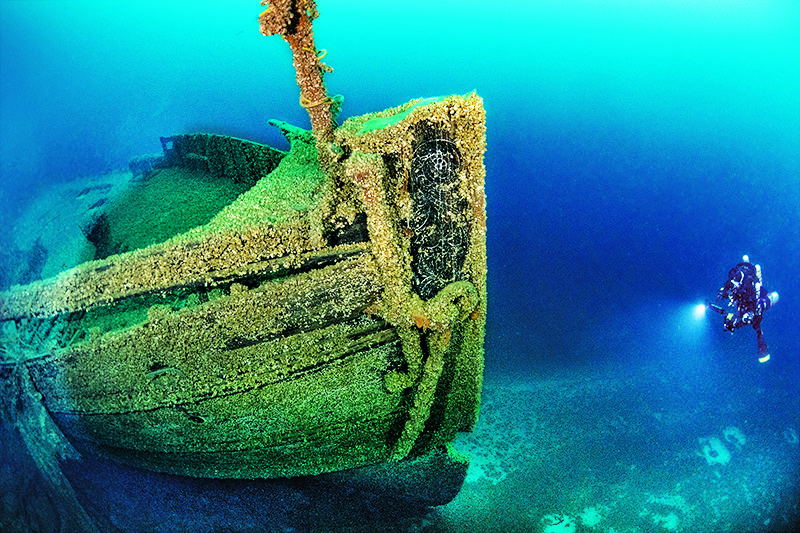
Vernon
In 1887 the steamer Vernon sank near Two Rivers, Wisconsin, in a gale that swamped the ship and took the lives of nearly 50 people, leaving only a single survivor. It was a narrow vessel built in 1886 to carry passengers and freight. As the Wisconsin Historical Society describes, it could travel up to 15 mph, which was fast for its time, but being so narrow with a deep draft caused it to become unstable at speed with full cargo.
Diving the Vernon is like visiting an underwater museum. Almost the entire wreck came into view as we neared its resting place at 210 feet. A large amount of mixed cargo is still inside, including 400 boxes of fish, 90 tons of pig iron, and barrels of what used to be apples and potatoes, along with wooden bowls and jugs, potato mashers, funnels, and more.
We saw bunks and the engine as we moved toward the stern. There are two anchors on the bow and beautiful scrollwork in the wood, which was remarkable to see since invasive quagga mussels cover so much of the wreck. Jitka illuminated the massive rudder and prop, which are still impressive after 135 years underwater. We spent nearly 40 minutes on the wreck because it was so enjoyable, and there was so much to see.
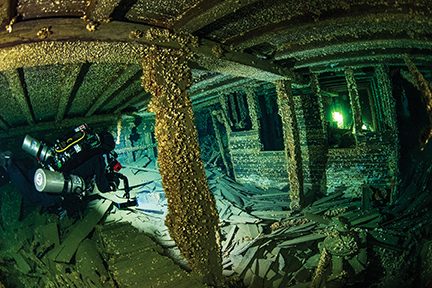
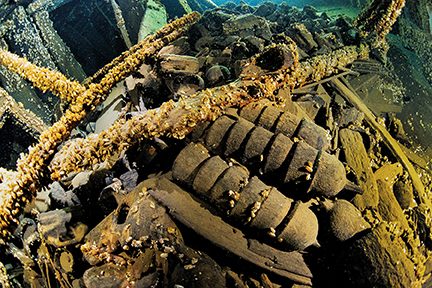
GALLINIPPER
A 95-foot schooner built in 1833, the Gallinipper is the oldest shipwreck found in Wisconsin waters. It transported goods from the east to Wisconsin and returned with furs. The ship passed to several owners and sank a few times before finally foundering in a storm in 1851 while carrying lumber from Milwaukee. Luckily a passing schooner rescued everyone aboard.
I could see the wreck when we were still 100 feet above it. It sits upright with a slight list to starboard but is fairly intact. The water was blue and clear with a lot of ambient light. Pulleys were still on the deck, and the bowsprit and windlass were on the bow.
Home
Built in 1843, the schooner Home departed Manitowoc, Wisconsin, on Oct. 16, 1858, with a cargo of merchandise and wood. It sailed through a dense fog and collided with the schooner Fiske early the next morning, sending the Home to the bottom of Lake Michigan. Rumors persist that many merchants who shipped goods on the ship opposed slavery and that the Home might have contributed in some way to the Underground Railroad, but nobody ever saw enslaved people aboard.
Its discovery in 1981 at 170 feet off Sheboygan made it the second-oldest shipwreck found in Wisconsin waters. The ship is upright and mostly intact, but the Rogers Street Fishing Village in Two Rivers displays the foremast.
Silver Lake
The Silver Lake is probably the most intact scow schooner in the Great Lakes and possibly the only one with double centerboards. Scow schooners had broad, shallow hulls and used centerboards rather than deep keels, which gave them stability and the ability to carry heavy cargo in shallow water.
The 95-foot, two-masted Silver Lake sank when it was basically cut in half by the car ferry Pere Marquette on a foggy morning in 1900. It was carrying maple wood from Green Bay to Racine, Wisconsin. One crew member drowned in the collision, while the others barely escaped.
The impact damage is obvious; as Jitka swam past and lit it, I could see the massive crack through the ship. The forward mast is still standing, and the bowsprit is intact, with anchor draft marks carved into the hull. Such complete examples of this type of ship are rare, making this wreck a Great Lakes gem.
Walter B. Allen
On April 16, 1880, a tug was towing the 136-foot two-masted schooner Walter B. Allen to Manitowoc, Wisconsin, for repairs when they were caught in a storm. The Allen took on water from breaking waves, which put out a steam pump on board. Twenty minutes later, the ship disappeared below the waves, but the entire crew made it onto the tug.
The wreck sits upright at 165 feet, but unfortunately its masts are now down on the wreck. We swam past the steam pump, which still sits on the deck. This wreck is very photogenic and just inside technical diving depths. The water clarity is so good that you can see the entire wreck, and the abundant ambient light makes it great for photography.
Recreational Sites
Popular recreational dive sites at WSCNMS include the Hetty Taylor at 100 feet and fairly close to shore. The Selah Chamberlain is at 87 feet and has a lot to explore, including a steam engine. The paddle wheeler Niagara has a fascinating history and is even shallower at just 55 feet.
Final Thoughts
After diving all five Great Lakes over the years, I’ve realized that each one is special. The Wisconsin coast has a variety of unique schooners and ships that are rare or maybe the only one of their kind so preserved. Wrecks range from depths of 3 feet to more than 300 feet, so even if you dive recreationally or are not a diver, a variety of wrecks can be explored.
It’s exciting that researchers are solving mysteries and discovering new shipwrecks, such as the Abiah, which has been underwater for 168 years and was recently added to the National Register of Historic Places. The Wisconsin Historical Society’s hard work and dedication have added 28 wrecks to the register. I hope the designation of this new sanctuary excites divers and nondivers to explore more of our maritime history and encourages future generations to protect the Great Lakes.
Treasure isn’t always coins or jewels — I saw nothing but treasure when I looked at each of these shipwrecks. After my last dive with Jitka on the Silver Lake, I left Wisconsin knowing I’ll have to return soon. I learned so much about the area and its hidden gems, yet I feel like I only got a small taste of what Wisconsin offers. When I was shooting each shipwreck, I’d stop to look past my viewfinder, staring in complete awe. You can’t help feeling inspired when experiencing these pieces of history frozen in time.
Thanks to the Wisconsin Historical Society’s Wisconsin Shipwrecks website for wreck information. AD
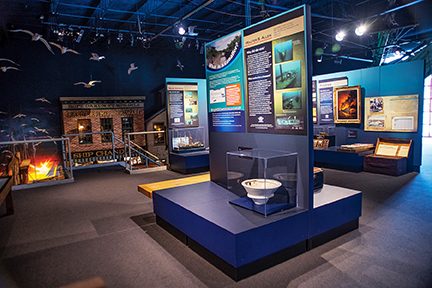
How to Dive It
Conditions: Water temperatures can range from 37°F to 65°F, so a drysuit with thick undergarments is best. The shallower sites are warmer during summer, so a 7 mm wetsuit might be enough. The best time of year to dive is June through September. Several charter operators run in this area.
Topside: Visit the Wisconsin Maritime Museum, or tour the USS Cobia submarine in Manitowoc. Check out the Rogers Street Fishing Village in Two Rivers, or pick up a paddleboard and see some shallow shipwrecks from the surface.
MORE INFORMATION
Wisconsin Shipwreck Coast Sanctuary: sanctuaries.noaa.gov/wisconsin
Wisconsin Historical Society: wisconsinhistory.org
Wisconsin Shipwrecks: wisconsinshipwrecks.org
Wisconsin Maritime Museum: wisconsinmaritime.org
More of Becky Schott’s Wisconsin shipwreck images: photos.liquidproductions.com/photos.liquidproductions.com/Wisconsin-Shipwrecks-Lake-Michigan-/i-pbcGW2n
Explore More
Learn more about the Wisconsin Shipwreck Coast National Marine Sanctuary in this video.
© Alert Diver — Q4 2022

